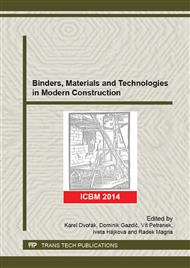p.106
p.112
p.116
p.120
p.124
p.128
p.133
p.138
p.142
Ultrasound Measurements for the Detection of Disintegration of Concrete Slabs Exposed to Fire
Abstract:
The paper presents the application of ultrasound measurements for the determination of structural alterations of concrete exposed to fire. Concrete is evaluated as an incombustible material, class A1, but the high exposure temperature, like in fire, may cause cracks and changes of internal structure. The ultrasound measurement is a nondestructive method. It is possible to measure ultrasound velocity before and after thermal loading. The ultrasound measurement could be used also at building side as to detect structural alterations after a fire or imperfection in concrete elements. Three different concrete mixtures were prepared and tested in this study. The basalt aggregate were used in the reference mixture and in a mixture with addition of polypropylene fibers (PP-fibers). The third concrete was made with light weight aggregates (LWA). The test slabs (dimension 10 × 30 × 1150 mm) were poured and cured in laboratory ambient (22°C and 40% RH) for 3 months. Then the slabs were exposed to fire, according to standard temperature-time curve ISO 834. The ultrasound velocity was determined on crossline screen of 10 points before and after heating of the concrete slabs. The results of ultrasound measurements indicate the changes of internal concrete structure. The cracks are formed by pressure of evaporating unbounded water and thermal extensibility of single components.
Info:
Periodical:
Pages:
124-127
Citation:
Online since:
April 2015
Authors:
Price:
Сopyright:
© 2015 Trans Tech Publications Ltd. All Rights Reserved
Share:
Citation:


